NÎMES – THE ROME OF SOUTHERN FRANCE
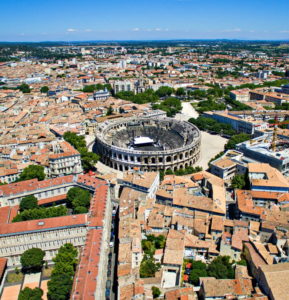
Located in the Languedoc on the border with Provence, between the Mediterranean and the hills of the Cevennes, Nîmes is one of the loveliest towns in southern France. It has the finest collection of Roman remains in France, and its pleasant little pedestrianised streets invite the visitor to explore the attractive old town, shady gardens and fountains. It’s also the perfect base for discovering the Cevennes national park to the north or the famous wetlands of the Camargue to the southeast, as well as the large number of other historic towns and sites in this part of France.
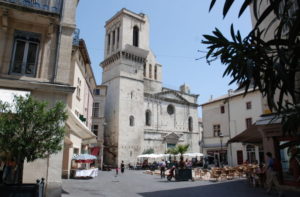
Ancient Colonia Nemausus was a city on the via Domitia, the first Roman road built in Gaul. Of the Roman remains, the two most important are of course the Maison Carrée (Square House), the best preserved Roman temple to be seen anywhere, and one of the largest amphitheatres in the south of France, Les Arenes de Nîmes. During the time of the emperor Augustus, the city was enclosed by ramparts more than 6 kms long, which were flanked by 80 towers, though only one remains today.

Over 2,000 years old, the amphitheatre once held 24,000 spectators. It’s still in regular use for events, concerts and summer festivals, including the Feria de Nîmes held in May. French bull-fighting is distinguished from the Spanish version by the fact that the bull is not killed. Right in the town centre, the sheer size of the two-tiered arena makes it dominate the town. From near the entrance you can still make out the sculpted heads of bulls just above the upper tier of arches.
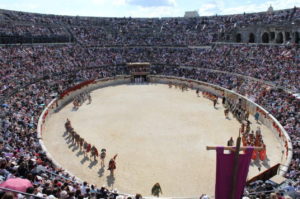
Once a year, there is the opportunity of reliving the Roman era—and dress like them too–at the annual Great Roman Games! On the first weekend in May you can enjoy one of the biggest re-enactment spectacles in Europe, with an imperial court, legionaries and local ‘Roman citizenry’. Over 500 actors and extras from all over France, Italy and Germany participate in the event.
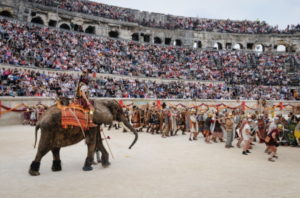
Each year, the Games has a different theme, depicting a highlight of the Roman era, with events in the amphitheatre such as gladiatorial combat, chariot racing and equestrian vaulting demonstrations. There are plenty of free entertainments as well, including fancy dress parades, guided tours of the archaeological museum and the Maison Carrée, and Roman weapon-handling workshops for children.
Even without this spectacle, it’s well worth visiting the arena, taking a seat high up in the stands to fully appreciate the magnitude of this huge space as well as its geometric perfection.
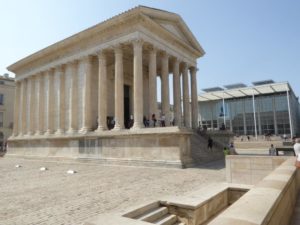
The beautiful Maison Carrée represents a textbook example of a Tuscan-style Roman temple as described by the classical architectural writer, Vitruvius in the first century BCE. It was probably constructed by Marcus Agrippa in 20 BCE, a close friend and son-in-law of the emperor Augustus. The temple once had a dedicatory inscription—removed in the Middle Ages, and since reconstructed—honouring the grandsons of the Emperor Augustus, Caius and Lucius Caesar.
The imposing temple was later used as part of the palace of the Visigothic kings who took over Gaul in the 5th century CE. It has long been admired for its sheer beauty and as a splendid example of Roman architecture, and it’s said that the American statesman Thomas Jefferson made drawings of it and used these when he designed the state capital in Richmond, Virginia.
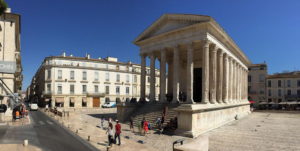
Over the centuries, the former temple became a house, a granary, and a church, and it was once even suggested as the tomb for the 16th century Duc d’Uzès.
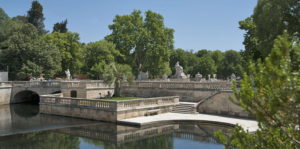
As a respite from antiquity, adjourn to the magnificent Jardins de la Fontaine. The 18th century gardens are as grand as you could wish for, based around the water source that prompted the Romans to found their city here.
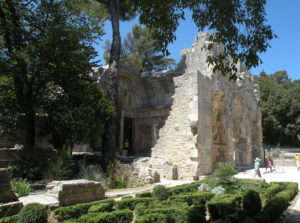
Opened in 1745, it was one of Europe’s first public gardens. There are regal balustrades and monumental staircases, numerous statues and marble urns, and on the far western side of the gardens are Roman ruins that are generally referred to as the ‘Temple of Diana’, although the exact function of the original structure is unknown—some scholars think it had been built as a library.
Opposite the Maison Carrée facing the same square, is an elegant modern building of concrete, glass and steel, the Carré d’Art.

An architectural competition to rejuvenate the square around the Maison Carrée was won by Britain’s Sir Norman Foster, who designed this library and space for modern art. There is a permanent collection of art focussing on 20th century art movements from the south of France and the Mediterranean, and temporary exhibitions are regularly hosted.

Nîmes is home to the second largest fine arts museum in Languedoc-Roussillon, the Musée des Beaux-Arts, founded in 1821, but relocated to an impressive, larger building in 1907. The museum is home to a fine collection of Roman mosaics and numerous works by the likes of Rubens and della Robbia.
One thing most people can probably name when they think of Nîmes is the town’s most famous export—denim. The tough cotton fabric was developed to create hard-wearing clothes for labourers, but today must surely be the most universal textile worn by all social classes and ages. There’s a room devoted to denim in the Musée de Vieux Nîmes.
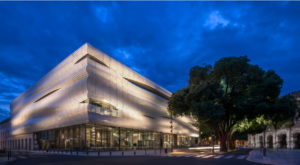
The latest drawcard in Nîmes is the magnificent new Museum of Roman History, the Musée de la Romanité. Designed by French-Brazilian architect Elizabeth de Portzamparc.

This fabulous museum makes use of innovative scenography—augmented reality, audio-visual technology, immersive projections and interactive cartography—as well as its rich archaeological collections, now beautifully displayed, which all add up to creating a vibrant experience of daily life in Nîmes during the Roman era.
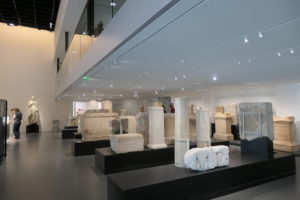
There’s also an excellent bookshop, a good café and a starred restaurant.
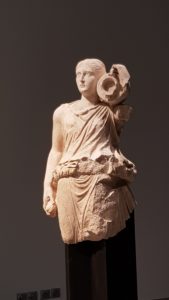
The town’s centre is relatively compact, and you couldn’t wish for a more agreeable place to stroll through the narrow, cobblestoned streets lined with local businesses, gourmet food shops, and plenty of cafes with their chairs and tables flowing out into the lanes, full of locals and visitors alike enjoying a meal or an aperitif with colleagues and friends.
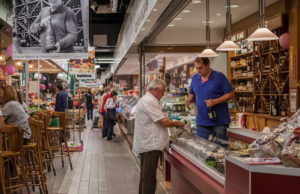
Head to the town’s Les Halles de Nîmes to salivate over the sumptuous displays of the finest regional produce, especially its famous picholine olives, and the freshest seafood such as bream or oysters. Bring a hearty appetite with you at lunchtime, as there’s a great selection of food bars offering a wide range local dishes to choose from.
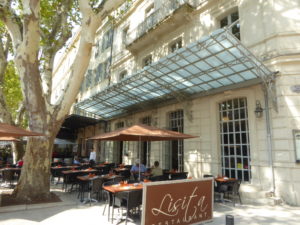
Nîmes is a perfect base to explore the region such as the Camargue as well as other Roman-era towns within easy reach. In particular though, and not to be missed, is the Pont du Gard, part of the stunning Roman aqueduct that supplied the city with water is only 22 kms from the town.
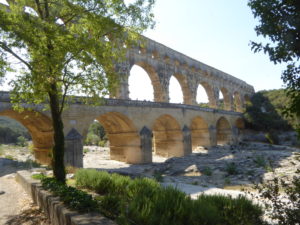


Leave a Reply